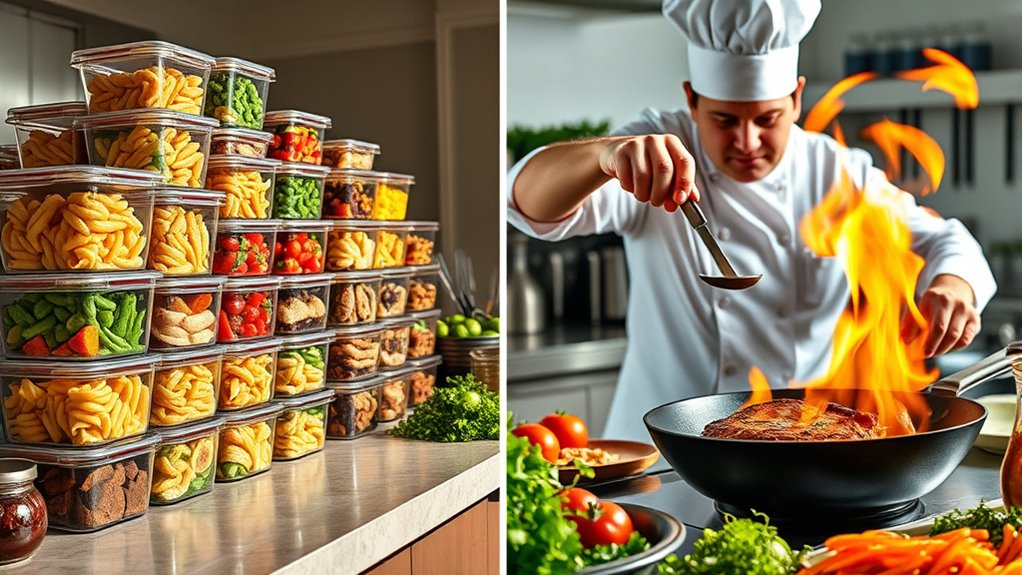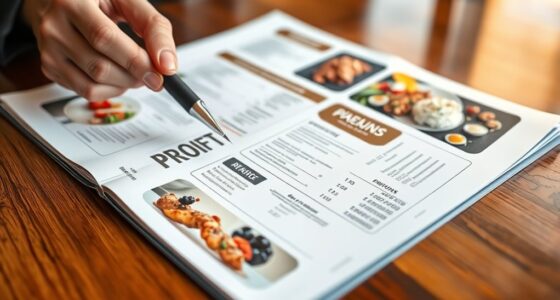Batch cooking involves preparing large quantities of food ahead of time, dividing it into portions, and storing it for busy days, saving you time and effort. In contrast, cooking à la minute means making each meal fresh just before eating, offering maximum freshness, flavor, and customization. Each method suits different lifestyles and preferences. Want to explore the advantages and challenges of each approach? Keep going to discover which technique fits your routine best.
Key Takeaways
- Batch cooking involves preparing large quantities of meals in advance for multiple days, stored for later use.
- Cooking à la minute is preparing each meal fresh, right before eating, emphasizing immediate flavor and customization.
- Batch cooking saves time and reduces daily cooking stress but requires planning, storage, and reheating considerations.
- Cooking à la minute offers freshly made dishes with more flavor variety but demands more daily effort and time.
- Both methods suit different lifestyles: batch cooking for efficiency and planning, à la minute for freshness and flexibility.

When it comes to preparing meals efficiently, you have two main options: batch cooking or cooking à la minute. Understanding the differences between these approaches helps you choose the best method to suit your lifestyle, optimize your kitchen efficiency, and stick to your meal prep strategies. Batch cooking involves preparing large quantities of food in advance, often for several days or even a week. You cook in bulk, divide the meals into portions, and store them in the fridge or freezer. This method is ideal if you want to save time during busy weekdays, reduce daily cooking stress, and ensure you always have nutritious options ready. It also helps eliminate the guesswork, so you don’t spend time deciding what to cook each day. On the other hand, cooking à la minute means preparing each meal fresh, right before eating. It’s more about immediate gratification, allowing you to enjoy freshly cooked food with full control over ingredients and flavors. This approach appeals to those who prioritize taste, variety, or enjoy the process of cooking as a hobby. While it might take more time each day, it often results in dishes that are more vibrant and customized to your current cravings.
Additionally, equipment maintenance such as proper cleaning and regular checkups of your tools can help ensure consistent results whether you choose batch cooking or à la minute. Both methods have their advantages and challenges. Batch cooking streamlines your meal prep strategies by reducing daily cooking time, which boosts kitchen efficiency. It’s particularly beneficial if you have a busy schedule or want to minimize the risk of eating unhealthy takeout. However, it requires planning and some upfront effort to cook and store meals properly. You also need to contemplate storage space and how well the dishes reheat without losing quality. Cooking à la minute, meanwhile, demands less planning but can be time-consuming, especially if you’re juggling other responsibilities. It gives you the flexibility to experiment with new recipes and enjoy a freshly cooked dish without leftovers. This method is perfect if you prefer variety or want to avoid eating the same meal repeatedly.
Ultimately, your choice depends on your priorities and lifestyle. If you value efficiency and convenience, batch cooking might be the best fit. If you prefer fresh flavors and enjoy the act of cooking itself, à la minute is likely more appealing. Both strategies can be integrated into your routine to maximize your kitchen efficiency and keep your meals enjoyable. Recognizing the strengths of each approach allows you to craft a flexible and effective meal prep plan that aligns with your goals.
Frequently Asked Questions
Which Method Is More Cost-Effective for Large Families?
Batch cooking is generally more cost-effective for large families because it allows you to do meal planning and ingredient prep in advance, reducing waste and saving money. By preparing large quantities at once, you can buy ingredients in bulk and minimize repetitive cooking. This approach also helps you stick to a budget, avoid impulse buys, and makes mealtime quicker and more efficient for busy households.
How Do Batch Cooking and À La Minute Impact Nutritional Quality?
You find that batch cooking often slightly reduces meal freshness and flavor preservation because dishes sit for a while before serving, which can affect nutritional quality. In contrast, à la minute cooking preserves the meal’s freshness and flavor better, ensuring you get the most nutrients and vibrant taste. If maintaining nutritional quality is your priority, preparing meals à la minute allows you to enjoy fresher, more nutrient-rich dishes.
Can Both Methods Accommodate Dietary Restrictions Effectively?
Yes, both methods can accommodate dietary restrictions effectively. With meal prep, you control ingredients and portion sizes, ensuring dietary needs are met while preserving flavor through careful storage. À la minute allows you to customize each dish, catering to specific restrictions and maintaining ideal flavor and texture. You adapt your approach depending on the restriction, ensuring nutritious, flavorful meals without sacrificing quality or variety.
What Equipment Is Essential for Efficient Batch Cooking?
You need essential equipment like large pots, sheet pans, and storage containers to streamline meal prep techniques. A sharp knife, cutting boards, and a reliable oven or stove are crucial for efficient kitchen organization. Invest in quality utensils and labeling supplies to keep everything tidy. These tools help you cook in bulk, save time, and stay organized, making batch cooking straightforward and effective for your dietary needs.
How Do Storage and Reheating Affect Food Safety?
You need to prioritize food safety by storing cooked foods properly using effective storage techniques, like airtight containers and keeping items at the right temperature. Reheating thoroughly guarantees harmful bacteria are eliminated, reducing the risk of foodborne illnesses. Always refrigerate leftovers within two hours, reheat to steaming hot, and avoid leaving food at unsafe temperatures. Good storage and reheating habits are essential for maintaining food safety and preventing health issues.
Conclusion
Understanding the difference between batch cooking and à la minute helps you choose the right approach for your meals. Did you know that home cooks who batch cook save up to 10 hours a week? Whether you prefer prepping in advance or enjoying freshly made dishes, knowing your options can make cooking more efficient and enjoyable. So, experiment with both methods and discover which method suits your lifestyle best!









